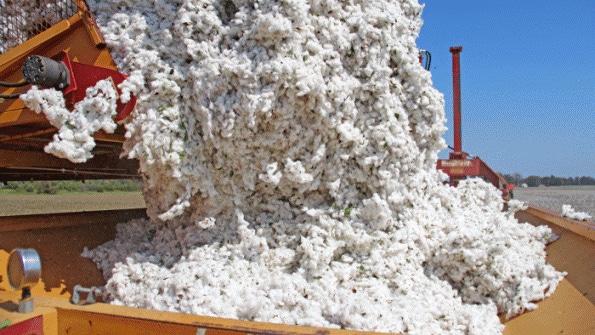September 19, 2012

High grain prices as a result of continuous drought in the Midwest could cause a potential shift in some Texas cotton acreage looking ahead to the 2013 crop year, according to Texas A&M AgriLife Extension Service economists.
John Robinson, AgriLife Extension cotton economist in College Station, said you would have to look back six years to when the Lone Star State last saw a significant change in cotton acres.
Cotton prices are predicted to be in a tight range in the near-term, although changes in world supply projections could trigger fluctuations. Producers can rely on options contracts to take advantage of price swings in both an up or down market.
“The last time we had a major reduction was over 20 percent in 2006-2007 as a result of higher grain prices,” he said.
“Even though we don’t grow a lot of soybeans, I hear stories of high sorghum prices that will tempt a lot of growers. I wouldn’t be surprised to see our acreage drop down 20 percent to about 5 million cotton acres.”
“There is the possibility, but it is limited,” said Mark Welch, AgriLife Extension economist in College Station.
“Grain sorghum in the High Plains is secondary if they have a failed cotton crop. Overall, cotton farmers are cotton farmers.”
The outcome of the 2013 wheat crop is the biggest question, Welch said, as prices continue an upward trend over the past three months. “If we get a bunch of rain, this could lead to a lot of opportunity,” he said.
Texas plants approximately 6 million wheat acres. If the state receives ample rain this fall, there could be an increase in harvested acreage and possibly an increase nationwide. This is in response to wheat following the recent run-up in corn prices, eclipsing more than $8 a bushel, Welch said.
“We are certainly setting ourselves up for a very large grain crop in 2013,” Welch said.
Robinson said cotton prices will “pretty much stay in a sideways channel.” “They’ve been just under 70 cents a pound to most recently 77 cents a pound,” he said.
“I’m expecting a continuation of a range, sideways action pattern bouncing around with some outside news. I’m expecting prices to trade anywhere from 80 cents to the low 70s.”
Robinson said prices could react accordingly to some type of world supply news, such as India, which hand harvests its cotton and could possibly come up a million bales short of expectations. “That might generate a market rally,” he said.
Marketing strategies for cotton producers this late in the season are limited. “There is not much in the options world you can do at the moment,” Robinson said.
“I think right now just getting the best cash offer you can is the main thing. If you are shopping around for call options you might be able to catch any upside surprise.”
Robinson said producers could take advantage of any possible volatility on the December 2013 futures by buying options “way in advance, so it may be worth shopping and thinking about what is affordable and what the price direction is.”
You May Also Like




